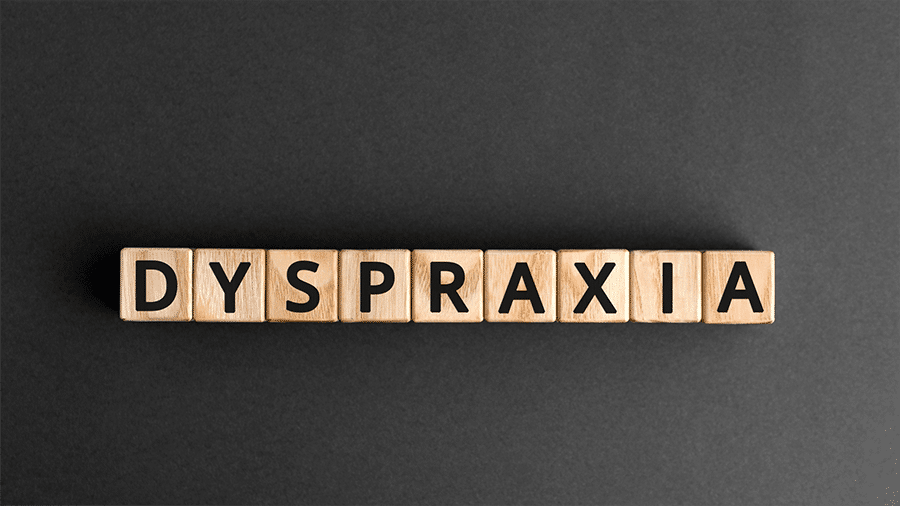Is your child clumsy or keeps on bumping on furniture? Does your child find it hard to play sports that require coordination? Does your child have difficulty riding a bike or have trouble doing tasks that need balance? Have you observed your child struggling to write or use small objects? Or does your child have difficulty speaking or uttering sounds?
These are only some of the observational signs of dyspraxia. It is a lifetime condition that affects kids, teenagers, and adults.

In this blog, you will get to know more about dyspraxia and gain a better understanding of how the Tomatis® Method can help your child with dyspraxia:

What is dyspraxia?
“A breakdown of praxis or action” is a medical definition of dyspraxia. It is the “inability to utilize voluntary mobile motor abilities effectively in all aspects of life from play to structured skilled tasks (Chu and Milloy).”
A person with dyspraxia or developmental coordination disorder (DCD) has problems with coordination and movement. Dyspraxia also affects your child’s gross and fine motor skills. It does not impact your child’s intelligence, but it can be related to cognitive skills difficulties.
The Diagnostic and Statistical Manual of Mental Disorders or DSM-5 of 2013 included dyspraxia/DCD as a motor disorder under neurodevelopmental disorder.
How common is dyspraxia?
Dyspraxia, a common brain-body disorder, is estimated at 5%-6% of school-aged children. According to a 2020 National Survey Evaluating the Impact of Developmental Coordination Disorder in Australia, it affects two children in every Australian classroom.
The survey also reveals that two-thirds of children had emotional and interpersonal difficulties. A study shows that boys are 1.7 to 2.8 times more likely to have the disorder than girls.
What are the types of dyspraxia?
There are different types of dyspraxia, which affects other functions and skills. Does your child fall in any of these types?

What causes dyspraxia?
Researchers have yet to pinpoint the exact cause or causes of dyspraxia. Some studies suggest connections with brain development, genetics, low birth weight, and environment.
- It may have something to do with improper brain or motor neuron development. The impaired brain function and process can lead to problems with coordination and movement.
- Children born prematurely below 32 weeks are at risk of dyspraxia. Those with low birth weights below 1,500 grams are also at risk.
- Is dyspraxia hereditary? A study reveals that the absence of paternally inherited FOXP2 gene caused developmental verbal dyspraxia.
- Dyspraxia is associated with a mother who has an alcohol or drug dependency during pregnancy.
What are the signs and symptoms of dyspraxia?
You may visit our page https://tomatis.com.au/who-do-we-help/developmental-challenges/dyspraxia/ for the list of symptoms of dyspraxia in adults and children.
How does dyspraxia affect adults and children?
There is increasing evidence that dyspraxia goes beyond motor skills or physical challenges. It impacts behaviour, mental function, and emotions.
The national survey found that 82% of families felt that dyspraxia hindered a child’s full potential in school. One in every four parents said their child did not enjoy going to school, too. A total of 92% of parents further showed concern that dyspraxia might negatively affect their child’s emotional and social health.
Studies by Poulsen et al. 2011, Stephenson and Chesson 2008, and Missiuna et al. 2008 reveal that people with dyspraxia are at risk of “opting out” or social isolation due to fear of embarrassment.
Later in life, your child may experience more challenges if left undiagnosed and untreated.
Impaired functional mobility may restrict activities of daily living of adults with dyspraxia. They may experience anxiety and fatigue as a result. They tend to develop other emotional and mental health problems. Their low employment status can aggravate it.

How is dyspraxia related to other disorders?
Dyspraxia can cooccur with other developmental and mood disorders. These are autism spectrum disorder (ASD), attention deficit hyperactive disorder (ADHD), anxiety, depression, and psychosocial difficulties. Comorbidity also includes learning problems.
- Dyspraxia and ADHD: About 30% to 50% of children with ADHD may have co-occurring motor problems. Children may have deficits in both gross and fine motor skills. Dyspraxia has a high rate of comorbidity with ADHD at 21.6% in the national survey.
- Dyspraxia and ASD: Dyspraxia can coexist with autism in adults exhibited by motor coordination difficulties. They are categorized as different disorders, but they share common characteristics. They are lifelong disorders that appear in the early stage of childhood. They may be mild to severe, marked by difficulties in socialization and communication. It has a comorbidity rate of 18% in the national survey.
- Dyspraxia and anxiety and depression: A study reveals that children with motor coordination problems experienced psychological distress. They showed more depression and anxiety symptoms than other typical children.
- Dyspraxia and psychosocial difficulties: A systemic review reports that children with dyspraxia had poor physical, psychological, and social functioning. They experienced more social problems and lower self-efficacy than their peers.
- Dyspraxia and learning problems: Dyspraxia has been linked to speech, communication, and language problems like articulatory speech deficits. Dysphagia is another learning disorder that impacts spelling and the ability to express words in writing. It involves fine motor skills with a comorbidity rate of 16.2% based on the national survey.

How is dyspraxia diagnosed?
There is no standard method of diagnosis for dyspraxia in Australia. The DSM-5 serves as a guide in meeting the following diagnostic criteria:
A. Learning and performing coordinated motor skills are below the expected average developmental age and opportunity for learning and use.
B. Motor skills deficit impacts activities of daily living, school productivity, and other activities appropriate for age.
C. The onset of symptoms is in the early developmental period.
D. Problems in motor skills can not be explained by intellectual disability, visual impairment, or neurological conditions affecting movement.
Your child may also be advised to undergo a neuromotor examination, which covers three aspects:
- Cranial nerve examination includes eye movements, response to visual presentation, and reactivity of pupils.
- Strength and flexibility exam is observing the functionality of the body. Clinicians note posture and performance of movement such as walking, climbing, or skipping.
- Motor planning for older children refers to the inability to create, plan, and do complex movements. These are gross and fine motor skills such as throwing a ball and tying a shoelace.
What are the dyspraxia treatments?
Can dyspraxia be cured? A study reveals that task-oriented and motor-training programs like occupational and physical therapies are useful for managing symptoms of dyspraxia. Children with handwriting problems, lower verbal or learning skills may benefit from neuromotor task training. While, cognitive orientation to daily occupational performance may be useful for children with more developed verbal skills. Speech therapy also works for dyspraxia to help people with oral or verbal dyspraxia.
Medications, such as methylphenidate, have been used to treat ADHD symptoms. It improves the attention and motor coordination of children with ADHD and dyspraxia. A study suggests that fatty acid can be offered as a safe and effective dyspraxia treatment option. This dietary supplement can improve behavioural and educational problems of children with dyspraxia.
It is best to consult a medical professional who will prescribe any of these treatment modalities based on your child’s evaluation.

Is the Tomatis® Method a dyspraxia treatment?
The Tomatis® Method serves as a supportive therapy for your child with dyspraxia. It improves the motor planning aspect of dyspraxia based on case studies. Speech therapists worked with the children who did not progress well. They recommended the children undergo supportive therapy. Certified Tomatis® professionals collaborated with speech therapists during the programs.
- Dyspraxia with severe comprehensive problem: A 2-year-old child could not speak much and had difficulty understanding simple instructions. The child underwent an initial Tomatis® program for 30 hours.
He continued with the program for another 2-eight-day sessions spaced four weeks apart. His comprehension improved, he became cooperative, and he expressed his feelings with words.
- Receptive and expressive dyspraxia: The child had moderate hearing loss after major surgeries due to a medical condition. Other than speech and language problems, he also had low muscle tone and fine motor difficulties. The child took eight intensive sessions of the Tomatis® program for one year.
He became talkative, friendly, and confident. Books and stories started to interest him. He was more aware of his surroundings and remembered places. His coordination and gross and fine motor skills improved.
Dyspraxia in adults and children is only one among many conditions that can be managed through the Tomatis ® Method. We are helping more than 200,000 children and adults yearly and worldwide.
How does the Tomatis® Method work for dyspraxia?
The Tomatis® Method certified professionals collaborate with occupational or speech therapists. They work at improving the motor planning skills of your child with dyspraxia.
Other than hearing, the ear plays a role in balance, coordination, and motor skills. The Tomatis® Method plays electronically modified music, sounds, or speech through an electronic ear or TalksUp®.
The filtered sounds stimulate the brain to create new pathways known as neuroplasticity. It enables the brain to adapt and learn new skills. It applies to balance, coordination, and motor skills.
Dr. Tomatis, founder of the Tomatis® Method, identified the ear structures which play a role in cognitive, emotional, and physical development. These inner ear structures are the vestibule and cochlear. Click here for the scientific explanation of the vestibule and cochlear functions in balance, coordination, and motor skills.
What are the benefits of the Tomatis® Method for your child with dyspraxia?
- It addresses the motor planning disorder associated with dyspraxia. The Tomatis® Method aids in developing the proper use, control, and coordination of the mouth and tongue muscles for speech and sound production.
- Oral skills: It refines the coordination of the structures of the mouth responsible for appropriate sounds. It improves muscles used for speaking, which results in better control of voluntary sound production.
- Verbal skills: Spoken words are clearer. Speech errors involving vowels and consonants decrease as language improves.
- In general, the Tomatis® Method brings positive behavioural, emotional, physical, and social changes to your child. It reduces anxiety and increases confidence as your child knows what to say and how to say it.
For more information about the Tomatis® Method Program for dyspraxia, call us at Tomatis® 0291 990 240 or email us at info@tomatis.com.au.
Françoise Nicoloff
Official Representative of Tomatis Developpement SA in Australia, Asia and South Pacific, Director of the Australian Tomatis® Method, Registered Psychologist, Certified Tomatis® Consultant Senior, Tomatis® International Trainer and Speaker, Co-author of the Listening Journey Series, 40 Years of Experience, Neurodiversity Speaker



